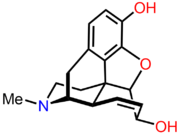Opioids
From Proteopedia
Opioids, broadly defined, are molecules that bind to the ligand-binding pocket of opioid receptors. These include morphine, endorphins, fentanyl and many other legal or illegal drugs. Sometimes, opioids are distinguished from opiates, drugs that are derived from opium by purification and sometimes modification. Opioids acting as agonists when bound to opioid receptors may be used to treat pain, but have other effects and side-effects. Opioids such as naloxone acting as antagonists, on the other hand, prevent agonists from binding and turn off the receptor. All opioid receptor agonists are addictive, and can lead to death by overdosing.
Contents |
Chemistry
Some opioids are alkaloids and some are peptides. The common structural features are an aromatic ring and a nitrogen atom that is charged at neutral pH. Alkaloids (such as morphine) contain multiple fused rings, leading to a T-shaped structure.Pharmacology
Different opioids are more or less potent depending on how fast and at what concentration they reach the receptor, how strongly they bind and how quickly they are degraded (pharmacokinetics). The mode of administration (e.g. oral, intra-nasal, sublingual, inhalation, intravenous, epidural, inter-cerebral) influences the pharmacokinetics, as does the water/lipid solubility and the acid/base properties of the opioid. The effects a specific opioid has (pharmacodynamics) depends on the selectivity of the opioid for the different types of opioid receptors and on differential ways of "turning on" the receptors, which have more than one "on" state.
Tolerance and addiction
With repeated use, the euphoric effect of opioids wanes, as does the capacity to reduce pain. As a consequence, there is a tendency to increase dosage over time. The danger of becoming addicted to a specific opioid depends on how strongly the administered dose activates receptors, which type of receptors are activated, and how long the activation persists. Short, intense bursts of activation are associated with the highest risk of addiction.
Overdose and treatment
Overdose causes respiratory arrest leading to death when not treated withing minutes. One treatment is nasal administration of the opioid naloxone, an antagonist that can compete with agonists quickly, leading to instant withdrawal but potentially saving the life of the patient. Treatment of opioid addiction is by medication (e.g. opioid maintenance and weaning treatment), social support and mental health therapy. Drug addiction has been described as a disease robbing patients of their free will [1], and relapses are an expected part of recovery.

